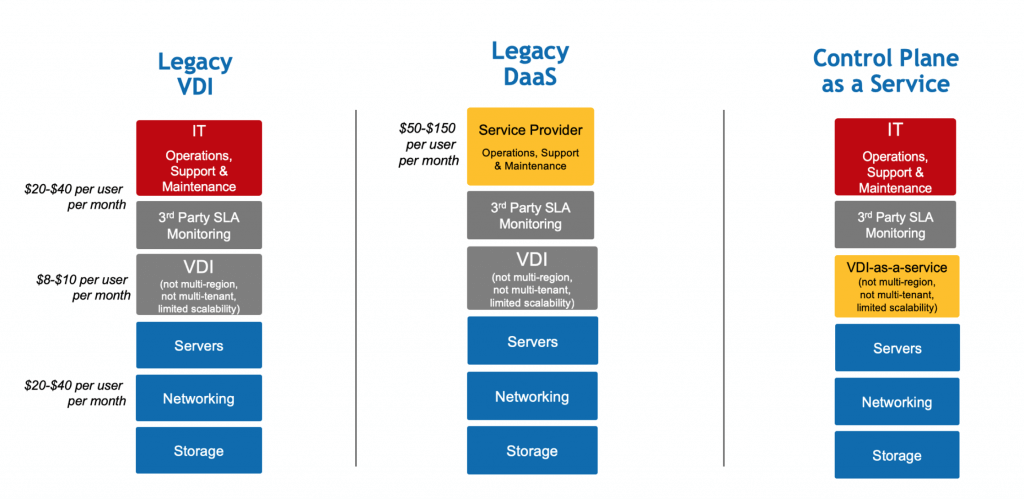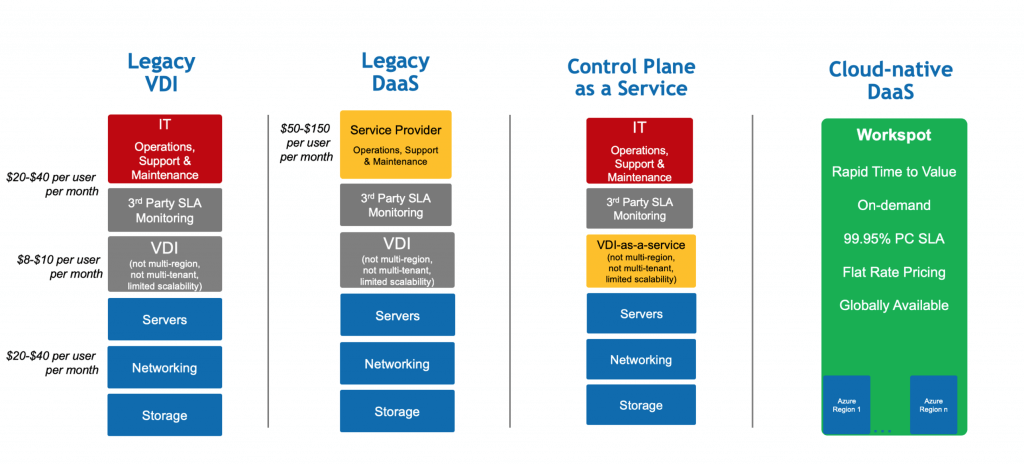Every day we receive inbound calls from enterprise architects and IT leaders who are looking for the right solution to accelerate business growth. Inevitably, they share with us the following:
(1) Our company has a cloud-first mandate: IT cannot deploy on-prem solutions unless a cloud service does not exist.
(2) We are looking for a cloud-native VDI/DaaS solution to give us flexibility and agility.
(3) We are intrigued by Workspot because we believe you are the only enterprise-class, cloud-native VDI/DaaS solution.
If I had a dollar for every time I’ve heard “we want out of the data center business” during conversations with CIOs, I’d be writing this blog from my yacht on the French Riviera. As IT leaders fulfill their cloud-first mandates, implementing virtual desktops is an obvious move because the right solution enables business agility and therefore, new opportunities that just have not been possible before, and that drives growth. What makes Workspot’s solutions cloud-native, and why that matters, is a very important topic to fully understand because it’s about business agility and business growth. Let’s talk about why a cloud-native Desktop-as-a-Service (DaaS) solution matters for the business, then we’ll drill down on the differences between the four approaches to implementing virtual desktops. Next week we’ll talk about why cloud-native DaaS matters for IT.
Value of Cloud-Native DaaS to Business
I’ll step through the some of the details of the four approaches, but first, here’s the bottom line for the business: A cloud-native VDI/DaaS solution needs to deliver fast time to value and business agility. You should be able to get your first desktop in days or a week (depending on how busy your IT folks are) – not months, and definitely not years. You should be able to start small – let’s say 50 users. Then you should be able to grow (or shrink) the number of desktops on-demand, sometimes in minutes, and sometimes in a few days depending on the situation, but definitely not months! A globally scalable architecture brings new levels of business agility, and that drives business growth.
Additionally, one of the biggest challenges with legacy VDI and legacy DaaS is end-user performance. Unlike these legacy solutions, the right cloud-native architecture will enable you to place your desktops in a cloud region close to each end user wherever they are in the world. Thus your users will get great performance because latency is negligible in most cases, and that means improved productivity. Finally, a cloud-native DaaS solution should be available anywhere on the planet, and you should make no compromises when it comes to performance and security.
Legacy VDI/Legacy DaaS On-Premises

Legacy on-prem VDI compared to Legacy Desktop-as-a-Service (DaaS)
Having laid that foundation, here’s what the stack for each legacy solution looks like. The best way to think about legacy VDI is that it is a do-it-yourself toolkit. You buy a VDI broker/provisioning engine, servers, storage, networking, and monitoring tools, and then you hire consultants to design and/or build the solution stack. In the legacy, on-prem VDI model, you need to do all the planning for the final, production deployment upfront. And all of this is done in the context of one data center because that is how these solutions are architected. You spend a bunch of time understanding the final deployment scale, architecting the solution for that scale, then requisitioning the infrastructure (software, servers, storage, networking, thin clients) required for deployment-at-scale. The up-front financial commitment is large and rigid. If you end up deploying to fewer users than originally planned, you will have wasted quite a bit of money on extra infrastructure. Historically, many legacy VDI projects were over-provisioned, because once they were deployed, users bearing the brunt of slow performance made their dissatisfaction known, and the projects would be scaled back significantly. In those rare instances when the project ended up requiring more infrastructure, you would be forced into conducting an expensive re-architecture and increasing your CapEx budget. With the legacy VDI model, you are responsible for the SLA of the service. If the virtual desktop is unavailable, you are responsible for all the troubleshooting; you have to determine whether it’s the software, the servers, the storage, or the network. This often leads to multiple problems where the server team, the storage team, the networking team, and the end user team all become involved in identifying which component has failed, and what to do about it. Oh, now you want VDI in a second data center? See above: Repeat. Yes, it’s really complex. But the worst thing is this complexity and rigidity actually inhibits business growth.
In legacy DaaS, a service provider delivers the virtual desktop service and takes responsibility for the SLA of the service. However, the service provider is essentially using the same single-tenant, single data-center VDI broker architecture to deliver the service. The architectural limitations of the underlying solution are still present and they still constrain many aspects of the service being delivered. It’s just that you’ve transferred ownership of all the complexity to someone else. All of the problems associated with a single-tenant, single data center architecture remain, and the performance problems that are intrinsic to this architecture remain as well. Plus, you can bet that all of the work that goes into maintaining and troubleshooting this infrastructure gets passed along to you in the form of service fees. The complexity is the same, it’s just someone else’s problem, although the resulting rigidity is still very much your problem, because that’s where you are limiting business growth opportunities.
Legacy VDI in the Cloud (aka Control-Plane-As-a-Service)
 Legacy on-prem VDI, Legacy DaaS & Control-Plane-As-a-Service Compared
Legacy on-prem VDI, Legacy DaaS & Control-Plane-As-a-Service Compared
Let’s add in “Control-Plane-As-a-Service” to the picture. This is what it looks like when vendors take their legacy solution and “cloud-enable” it. That’s a very different thing than being cloud-native, and in the era of massively scalable cloud solutions, that’s where the rubber meets the road, because only one of them is massively scalable. Also known as “Control Plane As-a-Service”, this approach uses someone else’s infrastructure (i.e. public cloud infrastructure), but you still have to implement and manage all the components of legacy VDI. It’s exactly like on-prem VDI, but you implement all the piece-parts on public cloud infrastructure. It’s the same single tenant, one-data center architecture that got dropped into a public cloud region, whether that’s Microsoft Azure, Google Cloud or Amazon Web Services. The key point is that you have to duplicate the control plane and all those VDI piece-parts into every, single cloud region in which you want to deploy virtual desktops. That takes a ton of IT resources to implement and manage on an ongoing basis. Same complexity, same rigidity, same lack of business agility. Why would you do that?
Cloud-Native DaaS Drives Business Growth: That’s Workspot!
 Legacy on-prem VDI, Legacy DaaS, Control-Plane-As-a-Service and Cloud-Native DaaS Compared
Legacy on-prem VDI, Legacy DaaS, Control-Plane-As-a-Service and Cloud-Native DaaS Compared
Cloud-native DaaS is green because green is good! With Workspot Desktop Cloud and Workstation Cloud, you’re subscribing to a turnkey service for delivery of your virtual desktops. You don’t mess with all the piece-parts at all. We do it for you. Enterprise architects tell us that these are the things they expect from a cloud-native DaaS solution so they can deliver value to the business:
- Fast time-to-value
- On-demand scalability
- High availability
- Pricing that supports their business model
- Globally available
- Performance that makes users happy
- Easily supports new use cases
All of these requirements impact business agility and productivity; they are exactly the right things to expect, and only a cloud-native DaaS solution can deliver them. Workspot supports cloud-first mandates, eliminates the complexity of legacy solutions, solves notorious performance problems, and brings new levels of security, flexibility, innovation, and agility to the business. That all adds up to a formula for accelerating business growth! To see for yourself how it works, schedule a demo with us and we can talk through your unique requirements.
Cloud Native Architecture




